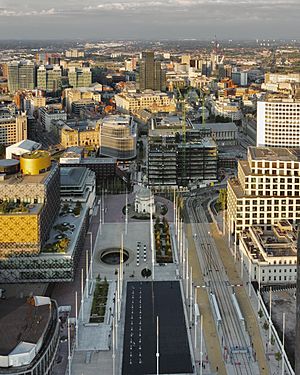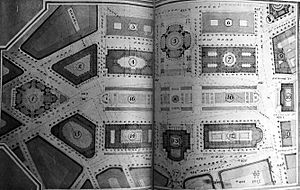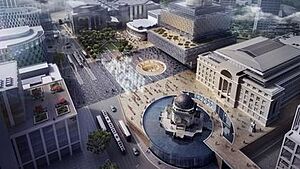Centenary Square facts for kids

Aerial view in 2021
|
|
| Maintained by | City of Birmingham |
|---|---|
| Location | Birmingham, England, UK |
| Coordinates | 52°28′45″N 1°54′30″W / 52.4791°N 1.9082°W |
| Construction | |
| Completion | 1920s (1991 redesign, 2019 2nd redesign) |
Centenary Square is a large public space in Birmingham, England. It's located on the north side of Broad Street. The square got its name in 1989 to celebrate 100 years since Birmingham became a city.
This area used to be full of small factories and canal docks. In the 1920s, the city council bought the land. They planned to build a grand city center with museums, offices, and an opera house. However, World War II stopped these plans. Only the Hall of Memory and part of Baskerville House were finished.
After the war, there were simpler plans, but they were never fully built. In 1991, the square was redesigned. It got new paving, lights, a fountain, and sculptures. Later, when the Library of Birmingham was built in 2013, some parts of the 1991 design were changed. A new amphitheater was added. The square was redesigned again between 2017 and 2019.
Today, Centenary Square is a busy place. It hosts many of Birmingham's big events. These include the Frankfurt Christmas Market, art festivals, and New Year's celebrations. Sometimes, you can even find a temporary ice rink and a Ferris wheel there!
Contents
History of the Square
Early Days
In the late 1700s, the area where Centenary Square now stands had many houses. In 1745, a famous printer named John Baskerville built his home, Easy Hill House, near where Baskerville House is today. He had a house, other buildings, and pretty gardens.
When John Baskerville died in 1775, he was buried on his property. In 1791, a group of angry people attacked and burned down his house during the Priestley Riots. The house was torn down soon after.
In 1821, a businessman bought the land. He dug a canal arm through the site to help his mill business. This canal, finished in 1825, led to more businesses opening. Other canal arms were dug, and the area became a busy industrial hub.
Big Plans for a Civic Centre
In 1918, a man named William Haywood suggested building a grand civic center. It would be west of Victoria Square. His idea included a cathedral, museums, an opera house, and gardens.
The city council cleared the area in the 1920s to create the open space we now call Centenary Square. The first building finished was the Hall of Memory in 1925. To build it, one of the canal arms was filled in.
In 1926, a design competition was held. The winning design was too expensive. So, a simpler plan was made. In 1936, another canal arm was filled in, allowing Baskerville House to be built. It was finished between 1938 and 1940. However, World War II stopped any more building plans for the civic center.
After the War
After World War II, new ideas for the civic center came up. One plan in 1940-41 suggested a tall column with a statue representing the "Spirit of Birmingham." This plan was adopted in 1944, but it was later dropped because it was too costly.
In 1958, a new design was proposed with water features and residential towers. Some of these ideas influenced later buildings.
In 1984, a building called Bingley Hall, at the west end of the square, was damaged by fire. The city council used this chance to build the International Convention Centre and Birmingham Symphony Hall. These opened in 1991 and 1992.
Centenary Square's New Look
To go with the new Convention Centre and Symphony Hall, the square was redeveloped in 1989. It was renamed Centenary Square to mark Birmingham's 100 years as a city. A bridge called Centenary Way was built over the Inner Ring Road. This made it easier for people to walk from the city center to the square.
Artist Tess Jaray designed the railings, street furniture, and paving. The paving used 525,000 stones laid out like a Persian rug. A fountain called Spirit of Enterprise was designed by Tom Lomax. David Patten created Industry and Genius, a tribute to John Baskerville, placed outside Baskerville House.
The main artwork was Forward, a sculpture named after the city's motto. It was designed by Raymond Mason and stood in the center of the square. Centenary Square officially opened in 1991.
For the millennium celebrations, a beacon called the Flame of Hope was set up. It was later removed when the Library of Birmingham was built. The Forward statue was sadly destroyed in 2003. A statue of King Edward VII was moved to the square in 2010. It now stands outside Baskerville House.
When the Library of Birmingham was built (2010–2013), the Spirit of Enterprise fountain was removed. An amphitheater was built in its place, connected to the library. In 2014, a statue called A Real Birmingham Family was unveiled outside the library.
Modern Redesign
In 2014, a competition was held to find a new design for the square. Five designs were chosen from 185 entries. The winning design, by Graeme Massie Architects, was announced in June 2015.
Building work on the new design started in April 2017 and was mostly finished in 2019. New security features were added to the square. A large, old tree was cut down to make way for these changes and a new tram line. The square was also part of the Commonwealth Social festival in 2019, celebrating the upcoming 2022 Commonwealth Games in Birmingham.
Buildings Around the Square
Centenary Square is surrounded by many important buildings:
- To the north: Birmingham Repertory Theatre (1971), Library of Birmingham (2013), and Baskerville House (1938).
- To the west: International Convention Centre (1991), Symphony Hall (1992), and Hyatt Hotel (1990).
- To the south: Broad Street, the Birmingham Municipal Bank headquarters (1933), One Centenary Square (2018), and Alpha Tower (1972).
- To the east: The Copthorne Hotel (1987) and One Centenary Way.
Art and Memorials
Many sculptures in the square were paid for by a special scheme. This scheme sets aside 1% of building costs for public art.
Current Artworks
- Boulton, Watt and Murdoch – This bronze statue shows three important men discussing engine plans. It was unveiled in 1956 and stands on Broad Street.
- Industry and Genius – Created in 1990, this artwork honors John Baskerville. It has eight stone blocks with bronze letters spelling "Virgil" – a poet whose work Baskerville translated. It's outside Baskerville House.
- Hall of Memory – A memorial building.
- King Edward VII statue – A statue of King Edward VII, moved to the square in 2010.
Former Artworks
- Forward – A sculpture by Raymond Mason from 1991. It was destroyed in 2003.
- Birmingham Wheel – A large Ferris wheel that appeared seasonally in the square. It was removed in 2006.
- Spirit of Enterprise – A fountain designed by Tom Lomax. This fountain has been removed.
Getting There
Many bus services stop near Centenary Square. In 2019, the West Midlands Metro tram line was extended to the Library of Birmingham. The tram line has since been extended further.
Images for kids
-
The Hall of Memory, Centenary Square
See also
 In Spanish: Plaza Centenario (Birmingham) para niños
In Spanish: Plaza Centenario (Birmingham) para niños









